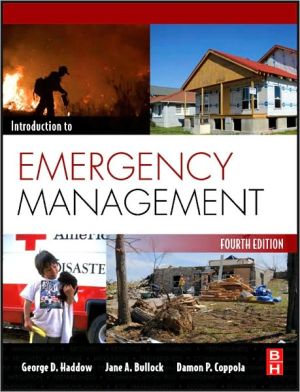Introduction to Emergency Management
Learn about the discipline of emergency management as it has developed over the past six decades, including the rapid evolution of the field since the turn of the century. Haddow, Bullock, and Coppola bring the ideal combination of practical and academic experience to their presentation of disaster preparedness, mitigation, response, recovery and communications. Extensive case studies cover the latest disasters, offering ample opportunity for current students and practitioners to build their...
Search in google:
Learn about the disciplines of emergency management as they have developed over the past six decades, including the rapid evolution of the field in this century. Haddow, Bullock, and Coppola bring the ideal combination of practical and academic experience to their presentation of the phases of disaster planning, mitigation, response, recovery and communications. Extensive discussions cover the latest disasters, offering ample opportunity for current students and practitioners to build their critical thinking skills and grow into the next generation of leaders in this increasingly important profession.
Introduction to Emergency Management\ \ By George D. Haddow Jane A. Bullock Damon P. Coppola \ ELSEVIER\ Copyright © 2011 Elsevier, Inc.\ All right reserved.\ ISBN: 978-1-85617-960-7 \ \ \ Chapter One\ The Historical Context of Emergency Management\ What You'll Learn\ * The early roots of emergency management\ * The modern history of emergency management in the United States\ * How FEMA came to exist and how it evolved during the 1980s, 1990s, and the early twenty-first century\ * The sudden changes to modern emergency management that resulted from the 9/11 terrorist attacks and Hurricane Katrina\ * Changes made by post-Hurricane Katrina legislation and a new administration in Washington, D.C.\ Introduction\ Emergency management has its roots in ancient history. Early hieroglyphics depict cave dwellers trying to deal with disasters. The Bible speaks of the many disasters that befell civilizations. In fact, the account of Moses parting the Red Sea could be interpreted as the first attempt at flood control. As long as there have been disasters, individuals and communities have tried to find ways to fix them, but organized attempts at disaster recovery did not occur until much later in modern history.\ This chapter discusses the historical, organizational, and legislative history of modern emergency management in the United States. Some of the significant events and people that have shaped the emergency management discipline over the years are reviewed. Understanding the history and evolution of emergency management is important because at different times, the concepts of emergency management have been applied differently. The definition of emergency management can be extremely broad and all-encompassing. Unlike other, more structured disciplines, it has expanded and contracted in response to events, congressional desires, and leadership styles.\ Recently, events and leadership, more than anything else, have brought about dramatic changes to emergency management in the United States. The terrorist attacks of September 11, 2001, led to massive organizational changes and programmatic shifts in emergency management. Many believe that these changes undermined the effective national system of emergency management that had evolved during the 1990s and led to the profound failure of all levels of emergency management in response to Hurricane Katrina in 2005.\ A simple definition for emergency management is "a discipline that deals with risk and risk avoidance." Risk represents a broad range of issues and includes an equally diverse set of players. The range of situations that could possibly involve emergency management or the emergency management system is extensive. This supports the premise that emergency management is integral to the security of everyone's daily lives and should be integrated into daily decisions and not just called on during times of disasters.\ Emergency management is an essential role of government. The Constitution gives the states the responsibility for public health and safety—hence the responsibility for public risks—with the federal government in a secondary role. The federal role is to help when the state, local, or individual entity is overwhelmed. This fundamental philosophy continues to guide the government function of emergency management.\ Based on this strong foundation, the validity of emergency management as a government function has never been in question. Entities and organizations fulfilling the emergency management function existed at the state and local levels long before the federal government became involved. But as events occurred, as political philosophies changed, and as the nation developed, the federal role in emergency management steadily increased.\ In the aftermath of the failed response to Hurricane Katrina, extensive discussion about emergency management, particularly the response and recovery functions, has taken place. An ever-increasing presence of nonprofit organizations delivering support to their particular constituencies after Katrina has given rise to interest on the part of the nonprofit community to take on increased responsibilities for disaster response. To date this has not materialized, but steps have been taken at the federal level to apply a top-down approach to emergency management functions, particularly relative to planning for disasters. While the Post-Katrina Emergency Management Reform Act detailed changes to how federal emergency management functioned, many of the changes included in this legislation were overlooked or were slow to be adopted by the leadership at the Federal Emergency Management Agency (FEMA) and the Department of Homeland Security (DHS). With the election of Barack Obama as president in 2008, both Congress and the emergency management community looked forward to positive changes and support for a struggling discipline.\ Early History: 18001950\ In 1803, a congressional act was passed that provided financial assistance to a New Hampshire town that had been devastated by fire. This was the first example of the federal government becoming involved in a local disaster. It was not until Franklin Roosevelt's administration used government as a tool to stimulate the economy that the federal government began to make significant investments in emergency management functions.\ During the 1930s, the Reconstruction Finance Corporation and the Bureau of Public Roads were both given the authority to make disaster loans available for repair and reconstruction of certain public facilities after disasters. The Tennessee Valley Authority was created during this time to produce hydroelectric power and, as a secondary purpose, to reduce flooding in the region.\ A significant piece of emergency management legislation was passed during this time. The Flood Control Act of 1934 gave the U.S. Army Corps of Engineers increased authority to design and build flood-control projects. This act has had a significant and long-lasting impact on emergency management in this country. This act reflected the philosophy that humans could control nature, thereby eliminating the risk of floods. Although this program would promote economic and population growth patterns along the nation's rivers, history has proven that this attempt at emergency management was both shortsighted and costly.\ The Cold War and the Rise of Civil Defense: the 1950s\ The next notable time frame for the evolution of emergency management was during the 1950s. The era of the Cold War presented the principal disaster risk as the potential for nuclear war and nuclear fallout. Civil defense programs proliferated across communities during this time. Individuals and communities were encouraged to build bomb shelters to protect themselves and their families from nuclear attack from the Soviet Union.\ Almost every community had a civil defense director, and most states had someone who represented civil defense in their state government hierarchy. By profession, these individuals were usually retired military personnel, and their operations received little political or financial support from their state or local governments. Equally often, their civil defense responsibilities were in addition to other duties.\ Federal support for these activities was vested in the Federal Civil Defense Administration (FCDA), an organization with little staff or financial resources whose main role was to provide technical assistance. In reality, the local and state civil defense directors were the first recognized face of emergency management in the United States.\ A companion office to the FCDA, the Office of Defense Mobilization was established in the Department of Defense (DOD). The primary functions of this office were to allow for quick mobilization of materials and production and stockpiling of critical materials in the event of a war. It included a function called emergency preparedness. In 1958, these two offices were merged into the Office of Civil and Defense Mobilization.\ The 1950s were a quiet time for large-scale natural disasters. Hurricane Hazel, a Category 4 hurricane, inflicted significant damage in Virginia and North Carolina in 1954; Hurricane Diane hit several mid-Atlantic and northeastern states in 1955; and Hurricane Audrey, the most damaging of the three storms, struck Louisiana and North Texas in 1957. Congressional response to these disasters followed a familiar pattern of ad hoc legislation to provide increased disaster assistance funds to the affected areas.\ As the 1960s started, three major natural disaster events occurred. In a sparsely populated area of Montana, the Hebgen Lake earthquake, measuring 7.3 on the Richter scale, was proof that states other than California were at risk for severe earthquakes. Also in 1960, Hurricane Donna hit the west coast of Florida, and Hurricane Carla blew into Texas in 1961. The incoming Kennedy administration decided to make a change to the federal approach to such disasters. In 1961 it created the Office of Emergency Preparedness inside the White House to deal with natural disasters. Civil defense responsibilities remained in the Office of Civil Defense within the DOD.\ Changes to Emergency Management: the 1960s\ As the 1960s progressed, the United States would be struck by a series of major natural disasters. The Ash Wednesday storm in 1962 devastated more than 620 miles of shoreline on the East Coast, producing more than $300 million in damages. In 1964, an earthquake measuring 9.2 on the Richter scale in Prince William Sound, Alaska, became front-page news throughout America and the world. This quake generated a tsunami that affected beaches as far down the Pacific Coast as California and killed 123 people. Hurricane Betsey in 1965 and Hurricane Camille in 1969 killed and injured hundreds of people and caused hundreds of millions of dollars in damage along the Gulf Coast.\ As with previous disasters, the response was passage of ad hoc legislation for funds. However, the financial losses resulting from Hurricane Betsey's path across Florida and Louisiana raised the issue of disaster insurance against future floods and a potential method to reduce continued government assistance after such disasters. Congressional interest was prompted by the unavailability of flood protection insurance on the standard homeowner policy. If this type of insurance was available, it was cost-prohibitive. These discussions eventually led to the passage of the National Flood Insurance Act of 1968, which created the National Flood Insurance Program (NFIP).\ Congressman Hale Boggs of Louisiana is appropriately credited with steering this unique legislation through Congress. Unlike previous emergency management/disaster legislation, this bill sought to do something about the risk before the disaster struck. It brought the concept of community-based mitigation into the practice of emergency management. In simple terms, when a community joined the NFIP, in exchange for making federally subsidized, low-cost flood insurance available to its citizens, the community had to pass an ordinance restricting future development in its floodplains. The federal government also agreed to help local communities by producing maps of their community's floodplains.\ The NFIP began as a voluntary program as part of a political compromise that Boggs reached with the then senator Tom Eagleton of Missouri. As a voluntary program, few communities joined. After Hurricane Camille struck the Louisiana, Alabama, and Mississippi coasts in 1969, the goals of the NFIP to protect people's financial investments and to reduce government disaster expenditures were not being met. Change would not occur until Hurricane Agnes devastated Florida in 1972.\ George Bernstein, who was brought down from New York by President Nixon to run the Federal Insurance Administration (FIA) within the Department of Housing and Urban Development (HUD), proposed linking the mandatory purchase of flood insurance to all homeowner loans that were backed by federal mortgages. This change created an incentive for communities to join the NFIP because a significant portion of the home mortgage market was federally backed. This change became the Flood Insurance Act of 1972.\ It is important to note how local and state governments chose to administer this flood risk program. Civil defense departments usually had the responsibility to deal with risks and disasters. Although the NFIP dealt with risk and risk avoidance, responsibilities for the NFIP were sent to local planning departments and state Departments of Natural Resources. This reaction is one illustration of the fragmented and piecemeal approach to emergency management that evolved during the 1960s and 1970s.\ (Continues...)\ \ \ \ \ Excerpted from Introduction to Emergency Management by George D. Haddow Jane A. Bullock Damon P. Coppola Copyright © 2011 by Elsevier, Inc.. Excerpted by permission of ELSEVIER. All rights reserved. No part of this excerpt may be reproduced or reprinted without permission in writing from the publisher.\ Excerpts are provided by Dial-A-Book Inc. solely for the personal use of visitors to this web site. \ \
IntroductionAcknowledgments1The Historical Context of Emergency Management12Natural and Technological Hazards and Risk Assessment153The Disciplines of Emergency Management: Migration374The Disciplines of Emergency Management: Response555The Disciplines of Emergency Management: Recovery956The Disciplines of Emergency Management: Preparedness1157The Disciplines of Emergency Management: Communications1418International Disaster Management1659Emergency Management and the New Terrorist Threat20110The Future of Emergency Management237References245App. AAcronyms249App. BEmergency Management Websites254App. CEmergency Management Agency Addresses256Index269About the Authors275
\ From the Publisher"Drawing heavily on recent case studies, this book examines emergency management as practiced in the United States at the federal level and by state and local agencies. The most recent disasters are covered, and up-to-date information on the role of emergency management agencies under the Obama administration is provided."--Foreign Service Journal, October 2011\ "Contained within this monograph are details and descriptions of contemporary emergency management practices and strategies, as well as descriptions of the key players involved in emergency management both within the United States and around the world. The authors' intent is to provide the reader with a working knowledge of how the functions of comprehensive emergency management operate and the influence they can have on everyday life. New to the fourth edition are an expanded coverage of risk management and disaster communications, more material on mitigation of disasters, and current information on the role of FEMA in the Obama administration."--MCEER.com\ "In this beginner’s guide to emergency management, Haddock, Bullock, and Coppola provide a well-rounded approach that fulfills the requirements of an introductory textbook. Their comments and assessments of the progress of emergency management lead the reader from early historical events-such as an 1803 New Hampshire fire-to some post-Katrina changes that affected national and local planning. The book reviews some of the history of the Federal Emergency Management Agency and its current organizational structure. This well referenced book is formatted to stimulate the reader to seek more information on this valuable subject and is a good starting point. The authors appear to be knowledgeable and experienced and have put together a well organized book."--Security Management\ \ \








